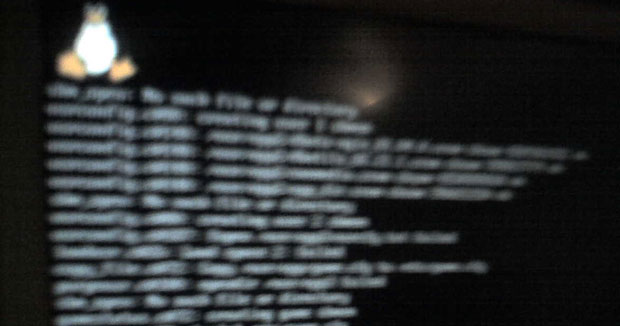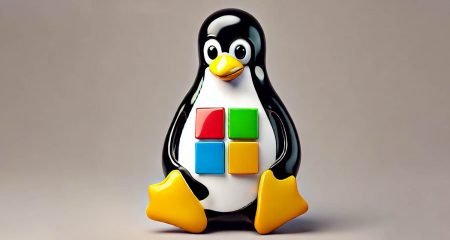
Linux, the free operating system that brought professional-grade computing to the lowly PC, has come a long way since doing something as simple as switching off meant performing secret handshakes or offering arcane prayers to the computer gods such as computername ~ # shutdown -h now. Today, practically all Linux distributions (some 450 are in circulation) hide their stark command lines behind prettified user interfaces such as Gnome, KDE, Enlightenment or Xfce, which mimic the desktop metaphor familiar to a billion Windows users. Should it ever be necessary, shutting down a Linux machine gracefully nowadays involves no more than a few clicks of a mouse.
Your correspondent has been a Linux fan since discovering the charms of Turbolinux, an early Japanese distribution, back in the 1990s. After the tribulations of Windows NT, he was pleasantly surprised by how easily Turbolinux resurrected a geriatric Pentium machine to give it new life as a print server in this newspaper’s Tokyo bureau.
Once set up, the Linux box just ran and ran without ever missing a beat. There were none of the viruses and other malware that plagued Windows and even Mac machines to worry about. And, if needed, there was a handy package-management tool for downloading and installing additional software. Later, as developers started to tailor Linux for use on the desktop, your correspondent migrated to Caldera’s OpenLinux and then Xandros, Knoppix, openSuSE and Kubuntu, before finally settling on the KDE version of Linux Mint.
The best thing going for Linux Mint has been the way that, while subscribing broadly to the principles of free and open-source software, it cheerfully incorporated proprietary drivers, codecs, utilities and plug-ins like Adobe’s Flash. The aim has always been to make life easier for users, rather than appease the open-source priesthood.
One criticism your correspondent has, though, is that when upgrading to a later version, Linux Mint requires users to do a complete reinstallation, rather than a rolling incremental update. He understands the reason why, but considers it an unwarranted chore. All the more so as new releases come every six months, fast on the heels of the latest version of Canonical’s popular Ubuntu (upon which Linux Mint is based; Ubuntu, itself, is based on Debian).
Not that users need to install every new version that comes along. But most of us have grown up believing, perhaps naively, that software tends to improve with development. And so the compulsion is to download a copy of the latest, greatest version from the distributor’s website, burn the “ISO” image onto a CD, reboot the computer, answer a few questions, and let the installation whirl away. Meanwhile, numerous additional packages, left off the CD for space reasons, are downloaded in the background. Setting up a modern Linux distribution as a fully fledged working system, with all the applications, drivers and tools you are ever likely to need, can be as easy as that.
Or, rather, it used to be as easy as that. Linux Mint 6 (“Felicia”) was a dream to install and use. But with successive versions, niggling problems have crept in. Some versions would not recognise a printer, an audio card or a wireless network, requiring tedious workarounds. Lately, video drivers have been another source of complaint. Power-saving features, which work fine on one laptop, refuse to do so on another. Several releases have proved so flaky that it has been easier to delete them and go back to an older, more stable version.
The most recent release, Linux Mint 12 (“Lisa”), has been the most frustrating yet. Your correspondent wasted much of last weekend trying to get it to work on one particular machine that has always been a model of good behaviour. But Linux Mint is not the only offender. Ubuntu has been plagued by even greater woes. It is beginning to look as though this deterioration in software standards is beginning to hobble all Linux distributions destined for the desktop.
Ubuntu’s problems seem typical. They stem, at least in part, from the way developers have tried to make desktop versions ever more attractive to non-technical users. Like Apple, with its OS X operating system for Macintosh computers, Ubuntu has embraced the “we know best” approach to desktop design, offering users less and less freedom to change the interface’s look and feel. In the latest release, Ubuntu users are given either the minimalist Gnome 3 version of the user interface, or a proprietary iPad-like interface called Unity. Both have driven many a long-time Ubuntu user nuts. Even Linus Torvalds, the father of Linux, has called Gnome 3, in particular, “an unholy mess” and has unceremoniously dumped it.
Meanwhile, the default for Linux Mint 12 is either Gnome 3 or a customised version of Gnome 2 called Mate. Neither has won rave reviews. For the initiated, both Ubuntu and Linux Mint can also be had with the venerable KDE interface. Many view KDE as being less intuitive, but a good deal easier to tweak for individual needs.
That said, even the latest KDE distributions are proving just as annoying to set up as Gnome versions. Your correspondent blames the rapid upgrade cycle for leaving too many features with rough edges, too many wonky drivers and utilities, and too many unchecked regressions (bugs caused by changes) in the kernel. All that Linux developers seem to want to do these days is add cool new features, rather than squish existing bugs and make the software more useable.
The problem is compounded by the way Linux has grown over the years into an ungainly edifice, built upon thousands of individual packages of computer code that have been stapled together. Contrast that with the strict quality assurance imposed by Apple and Google over their Unix- and Linux-like operating systems for tablets and phones. Both rely on just 100 or so tightly integrated core packages that have been carefully scrutinised for regressions and inconsistencies. Compared with Linux, the iOS and Android operating systems are remarkably clean and robust. With the quality of the underlying software a given, it is no surprise that developers have been able to write hundreds of thousands of effective apps for the two platforms.
Meanwhile, reports of Linux’s death have been greatly exaggerated. Linux enthusiasts, naturally, continue to see a bright future for the free operating system — pointing to its 1% share of installations (compared with Mac’s 7% and Windows’ 92%). It should be noted, however, that Linux accounted for around 2,5% of installations a decade ago. And while server editions of Linux continue to gain ground, desktop versions seem to be going nowhere.
To succeed on the desktop, Linux needs to penetrate the office. Unfortunately, there is no such thing as a single Linux to go up against Windows 7. What there is instead is a fragmented field of hundreds of different Linuxes, each with its own learning curve, skill set and maintenance needs. Even the top five distributions (Linux Mint, Ubuntu, Fedora, openSuSE and Debian) cannot offer a big enough user base to attract adequate support.
That is what is wrong with desktop Linux. Hobbyists and enthusiasts may be willing to invest their own time and effort to keep a desktop Linux running. But the corporate world cannot afford such luxuries. In business, the biggest single computing cost is not software licences, but the salaries of the support staff. And as far as licensing fees are concerned, the biggest single cost by far is not for operating systems but for enterprise applications.
In the circumstances, systems administrators do the rational thing: they install Windows machines on every desk, pay the Microsoft tax, and sleep easy at night, knowing there are plenty of maintenance people to keep their Windows networks running smoothly. Your correspondent, having wasted too much time maintaining Linux on the desktop, is about to do the same. Now let the angry ad hominems from the Linux faithful commence… — (c) 2012 The Economist![]()




